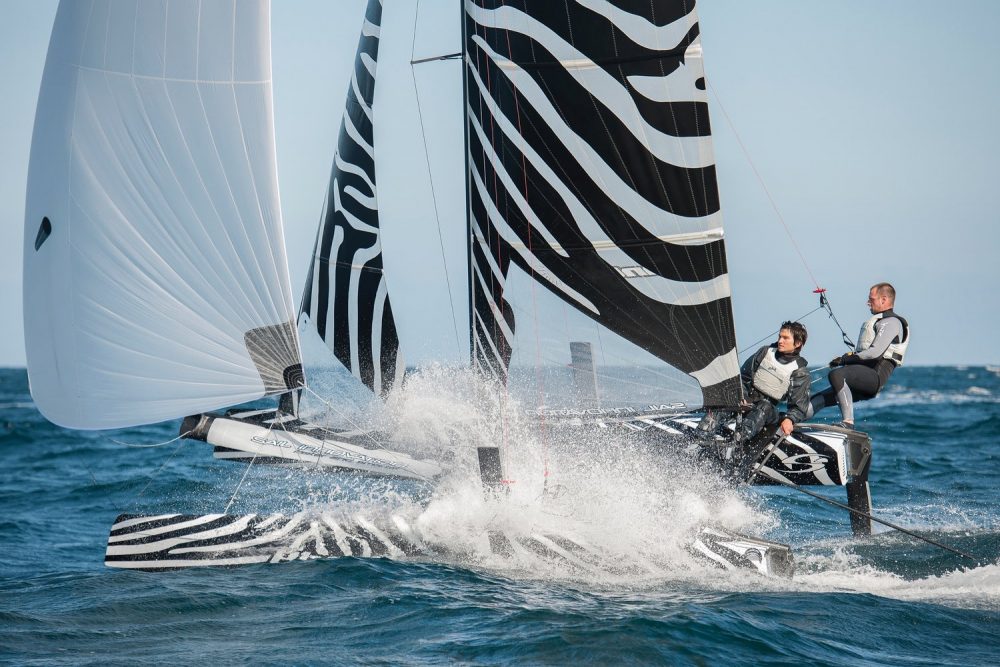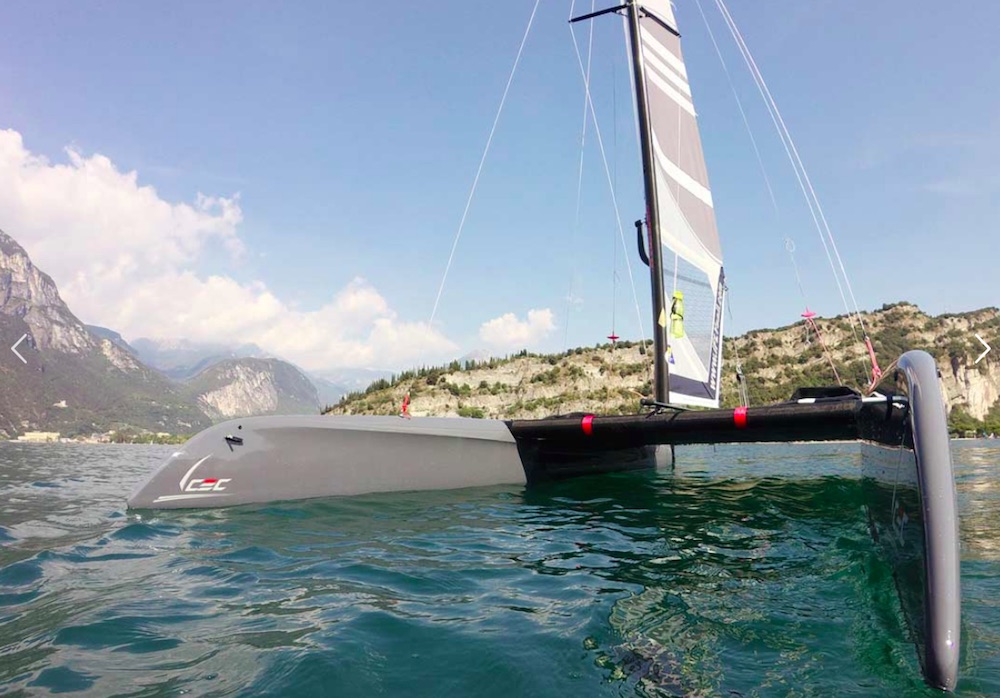Foiling Catamarans
When it comes to these foiling cats, sailing quickly becomes flying.
In 2013, the world sat up and took notice of foiling boats mostly due to the much-promoted America’s Cup. The AC72 catamarans flew across our TV screens with great speed and grace, hardly touching the water. These high-priced models achieved 40 knots in 17 knots of breeze with their T-shaped rudders and L-shaped daggerboards and in the process they charged the imagination of a new generation of sailors.
Hydrofoil sailboats have wing-like foils mounted under the hull. As the hull speed increases due to the pressure on the sails (in some cases with just 10 knots of true wind), the hull lifts out of the water, reducing the wetted surface and decreasing drag. The boat then sails or “flies” on the daggerboards only. Boat speeds in excess of twice the wind speed aren’t unusual.

Quick as the wind? You betcha.
Shapes
Foils come in different shapes. L-shaped (curved) foils, like those used on the America’s Cup AC45s and NACRA 20s, have no moving elements. T-shaped foils have a moving flap or trim tab on the trailing edge, which changes the amount of lift and therefore the ride height.
Hulls
Foiling boats can have one, two or three hulls and you may have seen someone sailing the Moth dinghy in your harbor. Most foiling boats regardless of hull number generally take some skill to manage safely. If you watch the well-choreographed movements of the America’s Cup teams, you must understand that they belie the difficulty of managing the pressure on these vessels and the power it takes to control them. Foiling catamarans often move so fast that whether they’re sailing upwind or downwind, they always look like their close hauled and sheeted in tight.
Top Manufacturers
Some examples of foiling cats include the NACRA 17 that raced in the 2016 Olympics and a modified version will be in Tokyo 2020. A step up in the series is the NACRA F20, which is similar in design, a bit longer, made of carbon fiber and equipped with curved daggerboards as foils and T-shaped rudders. The lightweight NACRA 20 has FCS (Flight Control System) that allows for adjustments to be made while foiling. The high-aspect Kevlar/carbon square-top mainsail catches the wind up high and the whole boat can be disassembled and packed into a 40-foot shipping container for travel to international regattas.
Another foiler is the Flying Phantom Ultimate. This 18-foot one-design racer has curved daggerboards and is being used in the Red Bull Foiling Generation Series. It can achieve 100 percent upwind foiling, which has been unheard of in this class of cats up until now. The hulls are light and have low freeboard to minimize windage and the daggerboards reach out to increase the righting moment.

iFLY15
iFLY is a 15-foot four-daggerboard foiler. The four T-shaped foils help stabilize the boat since they’re always in the water. The Automatic Foil System (AFS) supports a stable horizontal flight position and doesn’t have to be operated by the sailor during foiling so those with even average foiling skills can manage this vessel safely. Presumably, a few hours of practice is all it takes to fly one of these even at 30 knots.
The DNA F1 A-class catamaran is designed for single-handed foiling. The carbon pre-preg Z-shaped boards are combined with L-shaped rudders on this carbon fiber speedster. In the clear-coated carbon version, the boat looks more like weapon with its sleek hulls and reverse bows.
Another model that is presumably a snap to foil is the Formula Whisper, an all-carbon production version of the 20-foot foiling Solent Whisper. Built in the UK, this boat was designed by Ron Price as an affordable flying cat. With advancements like 3D printing the company has cut much cost out of the manufacturing of moving parts bringing the price under $30,000.
The world of America’s Cup racing is one that not many sailors can afford. The AC cup boats may have started the foiling and flying craze but few people breathe that rarified air and must settle for watching the big boys do the racing. However, if you’re determined to foil, don’t despair. Smaller models like the six mentioned above are within reach. Advancements in design make them easier to fly and innovations introduced throughout the build process make them affordable to mere mortals so why sail when you can fly?
Learn more about foiling catamarans, read our feature, America's Cup Foiling Technology Goes Mainstream. View all sailing catamaran listings.












